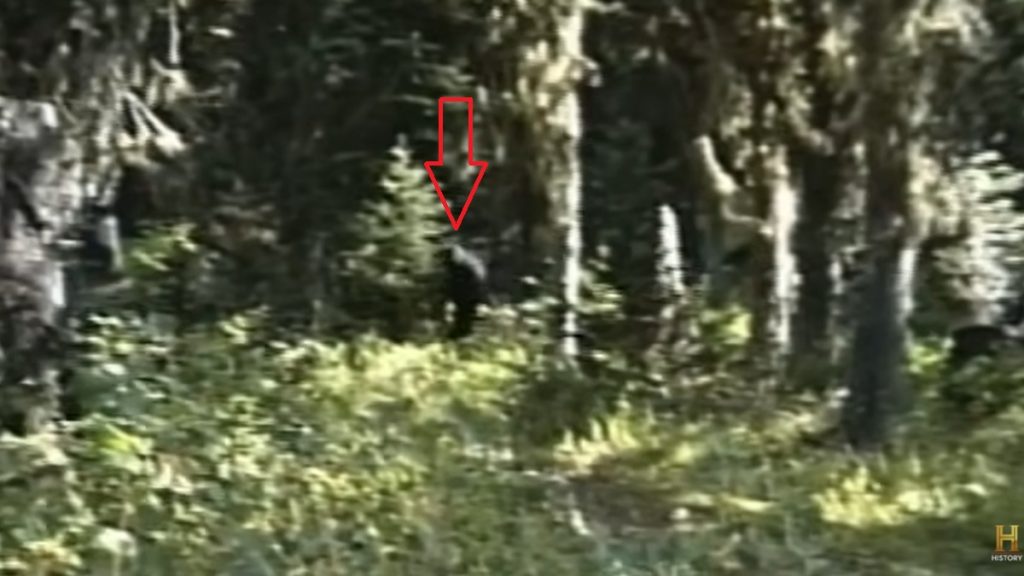
Forest ranger Paul Freeman filmed a suspected Bigfoot at Deduct Spring, Blue Mountains, Oregon, in 1992. Pic credit: via History/YouTube
Presenter Tony Harris examined the evidence supporting the claimed authenticity of Paul Freeman’s famous Bigfoot footage in a recent episode of The Proof Is Out There on History Channel.
He previously invited Michael Freeman, the late forest ranger’s son, to share his recollections of the day his father returned home, visibly shaken after encountering a Bigfoot near Deduct Spring, Blue Mountains, Oregon.
Harris also sought expert opinion on the Freeman footage (see video below). He said scientists he spoke with agreed that the video could be “legit.”
He concluded that expert opinion justified a closer look at the video.
Freeman tracked Bigfoot in the Blue Mountain region for 15 years
Freeman, a veteran US Forest Service Patrolman, encountered a suspected Bigfoot on August 20, 1992, at Deduct Spring, Oregon.
He started researching Bigfoot in Washington and Oregon woods following a chance encounter in 1982 with an alleged 10-foot monster while tracking an elk herd.
He decided that Deduct Spring, one of the few water sources for miles, was the best spot to search for the cryptid. Wildlife regularly visited the spring to drink, so he reckoned that Bigfoot would also come there.
He began investigating the Deduct Spring area and encountered multiple humanoid tracks. The tracks indicated that the creatures frequented the spring.
One day, while snooping around later than usual, he encountered two Sasquatch individuals (see video above) but filmed only one.
Sasquatch footage under scrutiny: Bigfoot or black bear?
Harris points out the most significant things to note in the video.
The first was the stride. It took long strides and raised its feet as if stepping over tall grass. It walked with its long arms swinging.
Analysts said that while the gait was humanoid (human-like), it was certainly not human.
Expert analysts also examined the details of the hair. They concluded it looked natural and not as they would expect of a costume or ghillie suit.
The scores of Bigfoot print casts that Freeman collected in the Blue Mountains between 1982 and 1997 also provided supporting evidence. Researchers believe Freeman collected between 50 and 75 Bigfoot print casts. Harris said that analysis of the casts suggested they were genuine.
Freeman returned home in shock, son recalled
According to Michael Freeman, his late father returned home in the evening one day looking deeply shaken and covered in dirt and sweat. He looked pale and trembled visibly. Michael said it was the first time in his life that he saw his father looking so scared.
Cliff Barackman, a researcher and close friend of the family, said he was impressed by the detailed research material that Freeman left behind. Wildlife and anthropology experts have examined the dataset and testified to its thoroughness.
But what impressed Barackman most was the footage. The creature bore a striking resemblance to the cryptid in the famous 1967 Patterson-Gimlin footage.
Expert verdict
Wildlife biologist Floyd Hayes examined the gait and ruled out a black bear.
He noted that black bears only walk briefly on their hind legs. However, the creature in the video appeared to walk routinely on its hind legs, indicating that it was fully bipedal. It also had a much flatter face than a black bear.
Anatomist and anthropologist Jeff Meldrum noted that the creature in the Patterson-Gimlin footage resembled the cryptid in Freeman’s video.
He also noted its massive size, small head set low on muscular shoulders, impressive arm length, and the naturalistic play of light on the fur as it walked along.
Meldrum added that expert studies of Freeman’s footprint casts and tracks supported his belief that the video was likely genuine.
